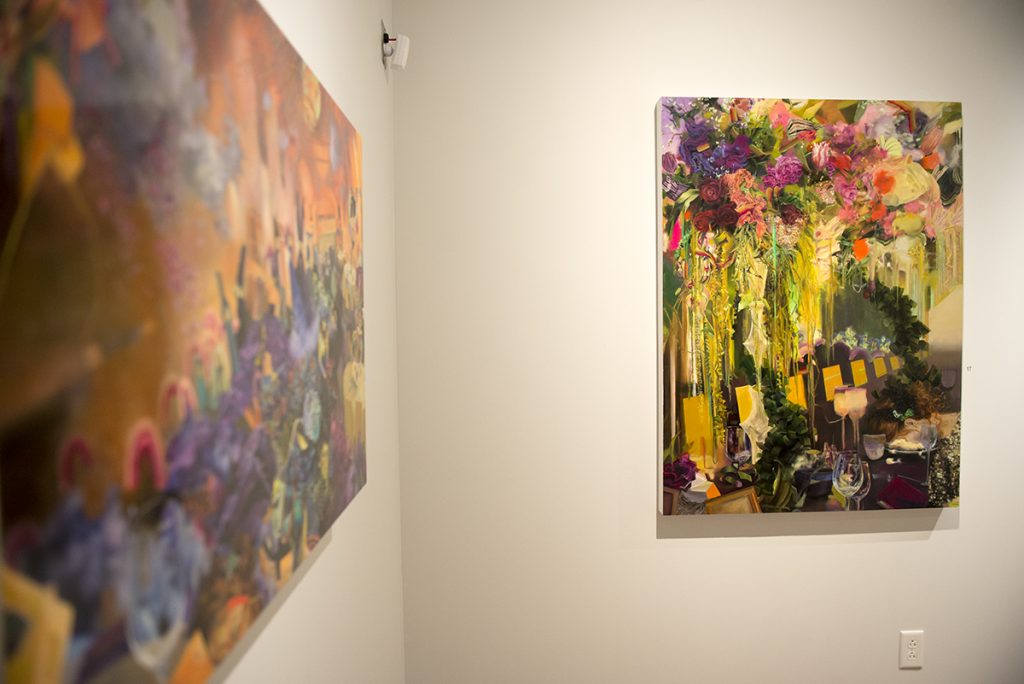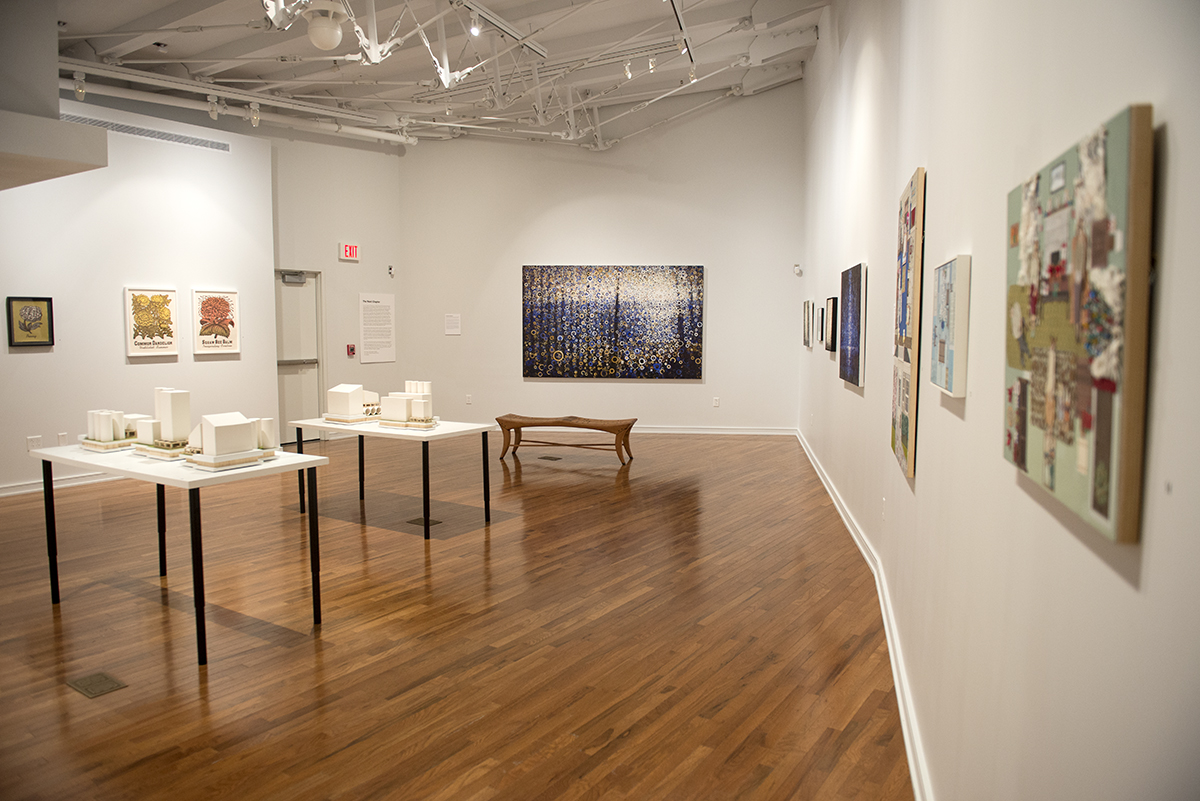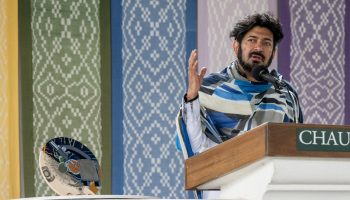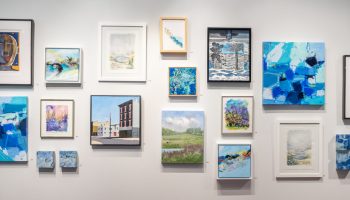“The Next Chapter: Works by Five Chautauqua School of Art Alumni” features two generations of summer School of Art participants. It is an excellent exhibition that will make VACI supporters proud for having had a hand in cultivating these strong talents. Martin Mazorra, Randall Stoltzfus and Ann Toebbe studied at Chautauqua during the early 1990s and each has maintained an active professional studio and busy exhibition schedule over the past 20 years. Ali Miller and Bobby Tso studied at the Institution during the early 2000s. Miller recently received an MFA and is teaching painting at Chautauqua this season. Tso is currently working on a master’s degree.
Located in the Gallo Family Gallery on the second floor of Strohl Art Center through Aug. 22, “The Next Chapter” is delightfully challenging and viewers will perhaps enjoy it most if they bring a friend and discuss the artists’ varied approaches as they walk through the exhibit.
The rich blue and gold of Stoltzfus’ large, painted abstractions draw viewers into the gallery. These glimmering works — some actually made with gold and palladium leaf — represent the modernist tradition. Indeed, like Kandinsky and Rothko before him, Stoltzfus seeks to represent through form and color the immaterial essence of pure spirit. In “Scarab,” he depicts a subtle luminosity emerging from a dense network of blacks. In “After,” the glow is more assertive, and suggests the final blast of a fireworks display, its image reflected out across the surface of a dark lake. Each composition is built through a laborious process of painting one circle after another until the entire surface of the canvas has been encrusted with the repeated pattern. Some may find Stoltzfus’ repetition of a single form cold or mechanical, perhaps at odds with the artist’s larger goal; others may liken its repetitive logic to chanting or prayer.

Tso clearly finds beauty in geometry and repetition, and celebrates it in the “Industrial Landscape Series,” five ceramic sculptures displayed on tables in the center of the gallery. Working with plaster slip-casting molds, Tso begins by producing a series of identical modules in a handful of basic shapes — cylinders, rectangles and trapeziums. He then fits these together like interchangeable building blocks in what could be extrapolated as potentially infinite combinations. It’s surprising how suggestive these basic shapes can be. A rectangular module standing vertically in one sculpture suggests a corporate high-rise; set on its side in another, it reads as an industrial warehouse. And while a set of three vertical cylinders resembles a bay of grain elevators in one piece, set on their side in another they become industrial irrigation conduits. As pleasing and approachable as Tso’s arrangements are, they also hold a certain gravitas by revealing the platonic forms that lie just beneath the muck of the everyday world.
Toebbe’s cut-paper collages recreating scenes drawn from old family snapshots are definitely a highpoint of the show. A good example is Toebbe’s “Margie and Neal,” which shows a middle-aged husband and wife looking toward the camera as they sit at their average drop-leaf table in their unremarkable suburban kitchen. A black Labrador retriever sits at Margie’s feet and one of the two cats shown sits remorselessly with its butt on the table in front of Neal. In short, the whole family has shown up, and this is no doubt the reason why the photo was taken in the first place. Toebbe’s carefully mixed colors perfectly capture the palette of aging Kodaks and the detail work involved cutting and gluing all the little pieces together is impressive. Still, the scenes become emotionally charged when we learn that Toebbe not only depicts her own previous homes here, but also “her husband’s home during his first marriage and the current home of his first wife, now on her second marriage.”
Mazorra’s woodcut prints are inspired by the “language of flowers,” a once charming way for young men and women to signal their feelings, through the wearing or giving of a flower: a Jasmine for faithfulness, a daisy for attachment and so on. Mazorra playfully disrupts the traditional symbolism by inserting his own invented messages beneath the rendered blooms. Unfortunately, most viewers won’t know enough of the historic references to fully grasp the artist’s poetic gesture, and this significantly weakens the impact of his works.
Viewers should not miss Miller’s hyperrealist paintings hanging in a small, adjacent gallery. Miller’s work represents the best of painting in the digital age. It is not difficult to see the influence of Adobe Photoshop and Flash animations software in Miller’s conceptualization of her complicated scenes. Her figures appear to be growing feathers and fish scales in neon purples and pinks and they stand around in complicated spaces knit together on the computer screen before being translated onto the canvas. Miller mixes the skill of a naturalist painter with the sensibility of a digital animator; her images don’t transport the viewer to other places as much as they offer a visual feast for our eyes.
“The Next Chapter” is open through the next three weeks and represents significant contemporary trends in the visual arts.
Patricia Briggs is curator and director of the Weeks Gallery at Jamestown Community College and her writing appears in Artforum, History of Photography, Woman’s Art Journal and elsewhere.






